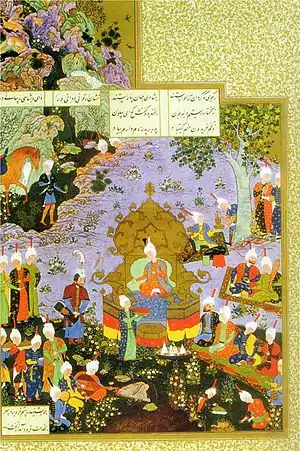Cup of Jamshid
The Cup of Jamshid (Persian: جام جم, jām-e Jam) is a cup of divination, which in Persian mythology was long possessed by the rulers of ancient Greater Iran. Its name is associated with Jamshid (Jam in New Persian), a mythological figure of Greater Iranian culture and tradition. The cup has also been called Jam-e Jahan nama, Jam-e Jahan Ara, Jam-e Giti nama, and Jam-e Kei-khosrow. The latter refers to Kaei Husravah in the Avesta, and Sushrava in the Vedas.

The cup has been the subject of many Persian poems and stories. Many authors ascribed the success of the Persian Empire to the possession of this artifact. It appears extensively in Persian literature.
The cup ("Jām") was said to be filled with an elixir of immortality and was used in scrying. As mentioned by Ali-Akbar Dehkhoda, it was believed that all seven heavens of the universe could be observed by looking into it (از هفت فلک در او مشاهده و معاینه کردی). It was believed to have been discovered in Persepolis in ancient times. The whole world was said to be reflected in it, and divinations within the cup were said to reveal deep truths. Sometimes, especially in popular depictions such as The Heroic Legend of Arslan, the cup has been visualized as a crystal ball. Helen Zimmern's English translation of the Shahnameh uses the term "crystal globe".[1]
The seven-ringed Cup of Jamshid is spoken of in the classic poem Rubaiyat by the 11th century Persian Omar Khayyam. See the 5th verse in the 5th translation by Edward Fitzgerald :
Iram indeed is gone with all his Rose, And Jamshyd's Sev'n-ring'd Cup where no one knows; But still a Ruby kindles in the Vine, And many a Garden by the Water blows.
It also finds mention in the Sawāneḥ, authored by Persian Sufi mystic Ahmad Ghazali[2] :
As long as the world-displaying goblet is in my hand, the wheel of heaven on high lowers itself before me / As long as the Kaʿba of non-being is the qebla of my being, the most sober man in the world is intoxicated by me.
See also
- Alchemy and chemistry in medieval Islam
- Cornucopia (mythical vessels with magical powers)
- Chalice of Doña Urraca
- Drinking horn
- Holy Chalice
- Holy Grail
- Mythological objects (list)
- Nanteos Cup
- Relic
- Sampo
References
- Shahnameh (The Epic of Kings): Bijan and Manijeh
- Nasrollah Pourjavady, "ḠAZĀLĪ,MAJD-AL-DĪN Abu’l-Fotūḥ AḤMAD b. Moḥammad b. Moḥammad b. Aḥmad" in Encyclopedia Iranica.


.png.webp)